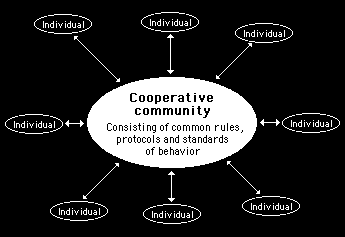
Chapter 4
Searching for an opportunity
The self centred virtual community
Communities are usually thought of as being based upon trust and loyalties. But, these are not relevant in an e-business environment because it has to be assumed that everyone will be looking out only for themselves and will help others only if it is in their interest to do so.
What kind of community can be created on this basis? To solve for this problem we have to tear up our idea of what a community is in the world of bricks and mortar and create a more practical version for the world of e-business.
The conventional idea of a community is that it provides an environment where people are tied together through a common set of rules and protocols. These rules and protocols override personal idiosyncrasies and there is great pressure on all individuals to obey implicit or explicit common codes of conduct. This is illustrated in figure 4.1

Figure 4.1
Conventional communities are based upon implicit or explicit common rules and understanding
A conventional community in the world of bricks and mortar would see the individual as being subservient to the community as a whole. Individuals would have to observe common protocols and rules of behavior and would not be expected to seek special privilege or advantage over anyone else. This also holds true in most e-mail discussion forums.
Outside of the e-mail discussion forums, an individual on the Internet is free to create their own virtual groups by establishing relationships with a number of other people. This is much like the strategy of an entrepreneur cultivating a number of key contacts, a sales person building a list of important clients or a contractor with a list of sub contractors.
This is a very different type of group from the conventional idea of a community because the individual who creates the group is effectively at the focal point of the group of contacts they establish. Yet, in the environment of the Internet this kind of group has to be treated as part of the community because of the massive connectivity.
It has to be appreciated here that the person who creates a group of personal contacts isn't the leader of that group any more than a sales person is the leader of the clients on their list of clients. They simply provide a personal concentration of communication, a local hot spot, in a vast network of interactivity.
It is probable that when a person forms such a group around themselves that every person in their group of contacts has also formed a group. This would allow for everyone in a network to be both at the centre of their own group but also at the periphery of many others. In diagrammatic form, a system of interconnected self centred groups would look like figure 4.2. In this figure, everyone is at the centered of a local group of eight contacts, yet, at the same time, they are also on the peripheral of eight groups where other people are the focal point.

Figure 4.2
People can simultaneously be at the center of focus of one group, yet, through the same contacts be on the periphery of other groups where other people are the centre of focus.
An example of a hot spot of communication is the collaborative group assembled together in the virtual cafe for the purpose of this book. To the author, these are fifty people focused on his project, but, to each of the people taking part in the cafe discussions, this is just one of many different communication activities they will be party to.
The bonds, which hold these individual centred groups together, is usually information exchange. By sharing knowledge and information an individual can form strong bonds with many others, especially where he or she can provide vital or strategic information to the people they have bonded with. In return, the individual will have on hand accessibility to the knowledge of their virtual group of contacts and will be able to rely on them to cover some of their own knowledge gaps or skill weaknesses.
The advantage of the Internet environment is that contact is not limited to one-to-one conversations. Groups of personal contacts can be gathered together for discussions. The nearest simile to this situation, in the world of bricks and mortar, is dinner parties: where groups of friends or business colleagues are invited along for an evening to exchange information, views and opinions.
The virtual cafe is the on-line equivalent of a dinner party. Special guests are , invited along for a short period of discussion. Interesting guests are invited back, boring guest's are not invited again. In this way, everyone running their own virtual cafes will gradually improve the quality of their own dinner parties.
The advantage of running such discussions in the environment of the Internet is that many of them can be run simultaneously. Also, it is possible to be at more than one discussion at the same time. Imagine being able to hold different dinner parties in every room of your house and, at the same time, be present at them all.
Imagine each of your guests also being at home having dinner parties of their own with you as one of their guests, while at the same time having a discussion with your group at your dinner party. This can happen in the environment of the Internet. Is it any wonder that it takes some people such a long time to wrap their heads around the possibilities available on the Internet.
(Note: More detailed explanations of groups and cafes are contained in the second book in this trilogy "The Ultimate Game of Strategy".)